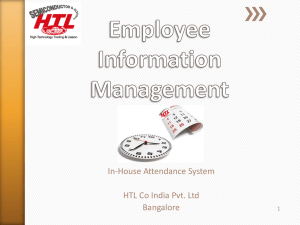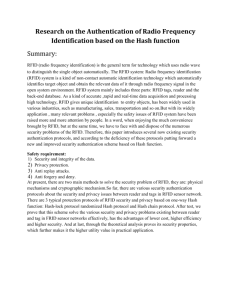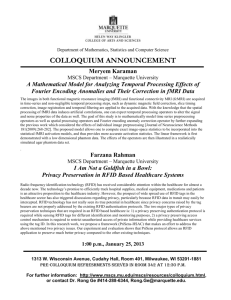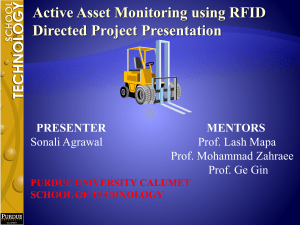MIS 101
advertisement
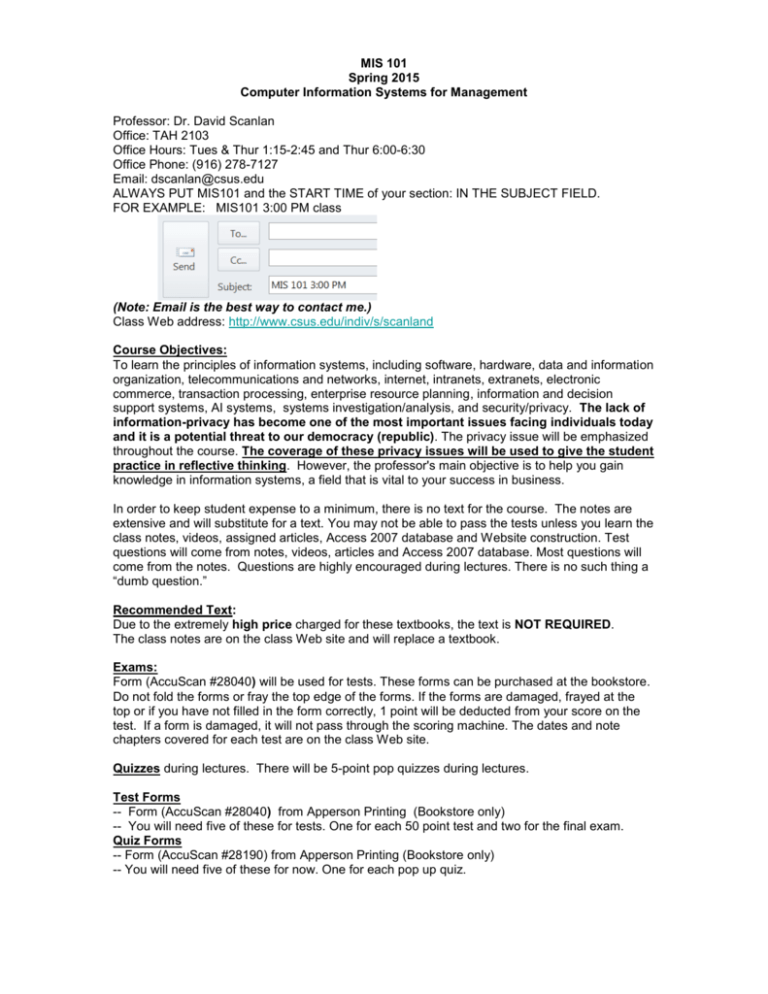
MIS 101 Spring 2015 Computer Information Systems for Management Professor: Dr. David Scanlan Office: TAH 2103 Office Hours: Tues & Thur 1:15-2:45 and Thur 6:00-6:30 Office Phone: (916) 278-7127 Email: dscanlan@csus.edu ALWAYS PUT MIS101 and the START TIME of your section: IN THE SUBJECT FIELD. FOR EXAMPLE: MIS101 3:00 PM class (Note: Email is the best way to contact me.) Class Web address: http://www.csus.edu/indiv/s/scanland Course Objectives: To learn the principles of information systems, including software, hardware, data and information organization, telecommunications and networks, internet, intranets, extranets, electronic commerce, transaction processing, enterprise resource planning, information and decision support systems, AI systems, systems investigation/analysis, and security/privacy. The lack of information-privacy has become one of the most important issues facing individuals today and it is a potential threat to our democracy (republic). The privacy issue will be emphasized throughout the course. The coverage of these privacy issues will be used to give the student practice in reflective thinking. However, the professor's main objective is to help you gain knowledge in information systems, a field that is vital to your success in business. In order to keep student expense to a minimum, there is no text for the course. The notes are extensive and will substitute for a text. You may not be able to pass the tests unless you learn the class notes, videos, assigned articles, Access 2007 database and Website construction. Test questions will come from notes, videos, articles and Access 2007 database. Most questions will come from the notes. Questions are highly encouraged during lectures. There is no such thing a “dumb question.” Recommended Text: Due to the extremely high price charged for these textbooks, the text is NOT REQUIRED. The class notes are on the class Web site and will replace a textbook. Exams: Form (AccuScan #28040) will be used for tests. These forms can be purchased at the bookstore. Do not fold the forms or fray the top edge of the forms. If the forms are damaged, frayed at the top or if you have not filled in the form correctly, 1 point will be deducted from your score on the test. If a form is damaged, it will not pass through the scoring machine. The dates and note chapters covered for each test are on the class Web site. Quizzes during lectures. There will be 5-point pop quizzes during lectures. Test Forms -- Form (AccuScan #28040) from Apperson Printing (Bookstore only) -- You will need five of these for tests. One for each 50 point test and two for the final exam. Quiz Forms -- Form (AccuScan #28190) from Apperson Printing (Bookstore only) -- You will need five of these for now. One for each pop up quiz. Letter Grading Policy: A = 90% and above B = 80% and above C = 70% and above D = 60% and above F = 59% and below Grades will be based on four test scores, quizzes, the database, and the Web project. Three test at 50 points each and a comprehensive final for 100 points. EXTRA CREDIT FOR NEAR PERFECT ATTENDANCE: No more than two missed classes will result in a 2% increase in your FINAL COURSE percentage. For example, if your FINAL COURSE percentage is 88%, attendance extra credit will result in a FINAL COURSE percentage of 90%. Thus you will receive an A for the FINAL COURSE grade. Five-digit ID number All students will be required to correctly use their RFID card's five-digit ID number on all tests and quizzes. Failure to use your correct five-digit ID number on a test and quizzes will result in a loss of one point. This requirement will be strictly enforced. The five-digit ID must be left justified in the appropriate box on the form and the ID number must be correctly bubbledin. You must have obtained this ID number by the START of the second week of classes. The RFID cards will be given out to students during the first or second week. Attendance will be taken using RFID cards. Extra points will be given for an attendance record of two or fewer classes missed. (You will be required to be in attendance the full period to be counted as attended. Any violation of this will result in the loss of all extra credit. In addition, this could be construed as an act of cheating.) NOTE: THE ATTENDANCE SYSTEM WILL AUTOMATICALLY SHUT DOWN TEN MINUTES AFTER THE START OF CLASS. NO ATTENDANCE CREDIT FOR THAT CLASS PERIOD WILL BE GIVEN AFTER THE MACHINE SHUTS DOWN. YOU MUST USE YOUR RFID CARD TO BE COUNTED AS ATTENDED. IF YOU FORGET YOUR RFID CARD, YOU WILL BE COUNTED ABSENT FOR THAT DAY. DR. SCANLAN WILL LOAN YOU THE RFID CARD WHICH MUST BE RETURN DURING THE FINAL EXAM. FAILURE TO RETURN OR REPLACE THE CARD WILL RESULT IN A LOSS OF ALL EXTRA CREDIT. 1. Project: Database A database project will be part of the course and its specific nature will be discussed in the near future. In general, the project will involve constructing a database with Microsoft’s Access 2007 and learning basic Access 2007 commands. A computer-based tutorial will be supplied at no cost. Teams of three or four students will work on the Access project. No credit will be given if a student is not part of a team. You may not do this project individually. If the DVD-R disk used to submit the Access project does not contain a working project, a grade of Zero will be given. CHECK AND RECHECK THE DISK. Also, if the Access project is late, 50% will be deducted. 2. Project: Website Presentation There will be about twenty teams, over a two week period, making Website presentations. Thus, five presentations during each class. Each team will have three students. The presentations will each be 3 to 5 minutes. POSSIBLE TOPICS FOR Website PRESENTATIONS: 1. How to control societies through technology 2. Smart grid used to control humans 3. Dangers of cell phone radiation 4. Dangers of cell tower radiation 5. Dangers of smart meter radiation 6. Internet of Things 7. Human RFID chipping 8. Dangers of WiFi radiation 9. The massive NSA data collection center in Utah and the Carnivore spy systems. 10. The history and dangers of fluoride and aspartame (included for reflective thinking) 11. The history and dangers of spraying nano-aluminum in the atmosphere (included for reflective thinking) 12. Watch the u-tube video on Orwell’s 1984 and apply today’s surveillance technology to eliminate privacy for societal control purposes. With today’s technology could society ever regain its freedom? 13. How does the red vs. blue pill and Plato’s Cave pertain to the USA today? (included for reflective thinking) 14. If the UN’s Agenda 21 is accomplished, what will the USA be like in the future? (included for reflective thinking) 15. Using RFID for supply chain management. 16. Bells and whistles on the latest Smart Phones 17. Security of RFID in credit cards 18. The use of Facebook and/or Twitter that could benefit businesses 19. Apps used in Apple’s iPad, iPhone, iTouch for business purposes 20. Apple’s transaction processing system used in their stores 21. Grocery stores of the future using RFID 22. Devise a system to make COSTCO more attractive to people with one or two items. 23. The above are just suggestions, because you can have any topic that relates to business. Talk to Dr. Scanlan for help on any of these topics above. Classroom behavior: Administrative withdrawal: Any repeated action/s that distracts others and/or disrupts the class WILL result in administrative withdrawal from the course and failure of the same. Repeated talking and lateness distracts other students. Also, any violation of this policy will result in the loss of extra credit for attendance. Any student who is deemed disruptive by the instructor will be given two copies of a letter in an envelope in class and that student will be required to sign and date one copy and to return the signed and dated copy to the instructor at the end of that class period. The student will retain one copy. A copy of the signed letter will be sent to the Dean of Students for filing. The first letter will serve as a warning. If a second letter is given, the process of administrative withdrawal from the course will commence. Any student who refuses to follow this procedure will be dropped from the course. Academic dishonesty policy: Any academic dishonesty WILL result in immediate course failure with further consequences likely. Reading Assignments: Approximate Week 1 2 2, 3 4 5, 6 7 8 9 10 11 12 13 14 15 Description History of computers Introduction to information systems Hardware: input, processing, and output devices Central processing unit and storage devices Organizing data and information: files and DBMS Access 2007 project announcement Software: Programming, operating systems, apps. Telecommunications Internet, Intranets, Extranets Electronic Commerce Transaction processing and ERP Management information systems and DSS AI, Expert Systems, and Virtual Reality Systems Investigation and Analysis Privacy and Security Class notes___ Class notes Class notes Class notes Class notes Class notes Class notes Class notes Class notes Class notes Class notes Class notes Class notes Class notes Class notes Note: The schedule for tests, the number of tests, the topics covered may be changed at the option of the instructor. The order of topics may also change. Due to AACSB accreditation requirements, the instructor may be absent from class for one or two days to present a paper at national and international conferences. THE CLASS WEB PAGE WILL BE CONSTANTLY UPDATED FOR ADDITIONAL RESOURCES SUCH AS Goals and Objectives Goal-1: To understand how the components of information systems function Goal-2: To learn how information systems are applied to business needs now and in the future Goal-3: To increase student awareness of the survalience system in the USA Goal-4: To encourage students to think “out of the box” (reflective thinking) Goal-5: To generate an appreciation for present information systems Examples of Objectives for Goal-1 1. How hardware functions 2. How databases function 3. How systems are developed Examples of Objectives for Goal-2 1. To view videos showing business systems 2. To solve case studies 3. To read articles involving current and future systems Examples of Objectives for Goal-3 1. Business bait and switch 2. IBM and Hitler 3. Chipping humans 4. Banks putting RFID in credit cards without warning customers of possible theft of data. 5. Google tapping into WiFi 6. Violations of individuals’ privacy Examples of Objectives for Goal-4 1. To learn about Plato’s Cave (It is difficult to think “out of the Cave (box)” until you realize that you are in a cave that CONTROLS your thinking.) 2. Solving Case studies 3. Exposing commonly held beliefs that may be false 4. Some understanding of how propaganda (PR) works. Propaganda shapes our thinking. Examples of Objectives for Goal-5 1. Learning about the history of computers 2. Learning about early approaches to database systems, programming languages, and operating systems.
